
Aphid genome unravelled
Leiden evolutionary biologist Maurijn van der Zee has co-operated on an enormous international project to describe the genetic material of the pea aphid Acyrthosiphon pisum. The more than 100 authors involved in the project have published their findings in the online magazine PLoS Biology.
Nested doll principle
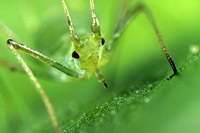
The genome contains the information to make four totally different types of this aphid: males, flying reproductive females and non-reproductive females with or without wings. The females without wings carry in their abdomen a new generation of wingless females, that in turn also become pregnant. This 'nested doll principle' means that aphids can form an enormous plague in a very short space of time. If a plant becomes overcrowded, flying non-reproductive females are produced that spread out and establish themselves on new plants. In winter, sexual females are produced that mate with males and lay eggs that can survive the winter.
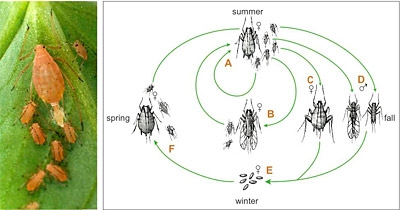
Different morphs
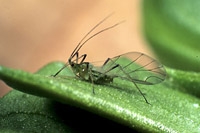
One of the most striking outcomes of the research is that the aphid genome contains many more duplicated genes than the genome of other insects. Gene duplications occur in all types of creatures, but what often happens is that over time one of the duplicates fails. In the case of the aphid, all the duplicates seem to be fully functional. It may be that the aphid needs so many slighly different variants of the gene to be able to produce all the different morphs: the males, the flying females and the non-reproductive females. Further research will focus on this question.
Symbiosis
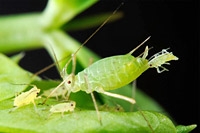
Aphids live in a symbiotic relationship with the Buchnera aphidicola bacterium. This bacterium produces essential amino acids for the aphid that the insect cannot make for itself, and in its turn, the aphid produces essential amino acids for the bacterium. This vital symbiosis is also reflected in the genome: the aphid lacks a number of essential genes that are present in the bacterium, and vice versa. Twelve genes have even moved from the bacterium genome to the genome of the aphid. This resembles the development of animal mitochondria: these energy factories in our cells were once free-floating bacteria, but have now become simple elements of the animal cell. Their bacterial genes have largely moved to the animal cell nucleus.
Ants
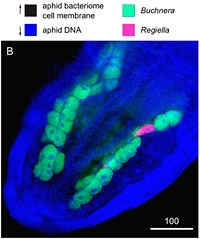
Aphids are also involved in yet another surprising symbiosis: they live in a symbiotic relationship with ants. The aphids excrete sugars in exchange for protection, a partnership that may once have had a logical origin. The aphids extract sap from plants, but the sap contains so much sugar that the insects have to excrete the excess. Ants make use of this process; their aggressive presence ensures that aphid predators such as ladybirds are kept at a distance. Today we see that aphids actively excrete sugars to attract ants, and the ants in their turn actively 'milk' the aphids to acquire sugars.
Veni subsidy
Van der Zee was asked to co-operate on the sequencing project because of his experience with describing another insect genome: that of the flour beetle Tribolium castaneum. He will be continuing his work on this beetle over the coming three years in Leiden, funded by a Veni subsidy. 'The funny thing is that I have never actually seen this aphid,' comments Van der Zee. ‘The only thing I needed was a computer to discover in the sequence of As, Cs, Gs and Ts what kinds of genes were contained in the genome. These kinds of projects are the species description of the 21st century. In themselves, they are not particularly interesting, but they do provide a foundation for further research, in this case, for example, into how to prevent plagues of aphids.'
Link
- The article Genome Sequence of the Pea Aphid Acyrthosiphon pisum . PLoS Biol 8(2):e1000313.
